In the first part of this two-part series on inflation and deflation we discussed how money came to be used to facilitate trade. Metals were the best commodities for use as money because they were durable, relatively rare, and were easy to mold into identical pieces. As the wealth of people grew, however, they’re store of metals came to be heavy and difficult to secure. For this reason people came to rely on specialists to whom they would entrust their gold for a fee. In return they were given a paper receipt showing that they were entitled to retrieve a certain amount of gold from the vault. For the sake of clarity we’ll call this type of specialist a “deposit banker.” If you wanted to pay someone in gold, you would simply give them your receipts for the gold in your deposit banker’s vault. In this way, paper eventually traded as if it were the gold itself.
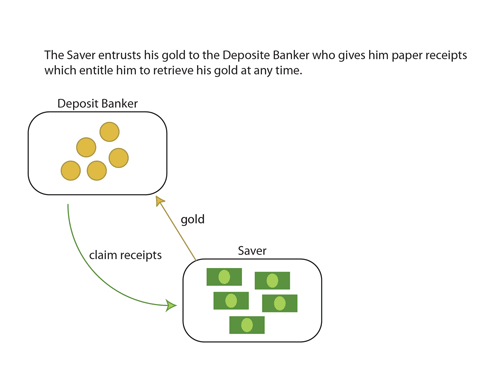
There was another type of specialist who dealt with people’s savings. This specialist we’ll call the “loan banker”. The loan banker would loan out savings (either his own or someone else’s) to a borrower for a small fee which today we call “interest.” (Interest is a complicated enough concept to warrant an article in it’s own right, so for now, we will simply define it as the fee a borrower pays for the use of another person’s savings.) The loan banker who loans out his own savings obviously keeps the interest for himself, but a loan banker could also loan out another person’s savings and make a profit by charging to the borrower a slightly higher rate of interest than he pays to the saver. For example:
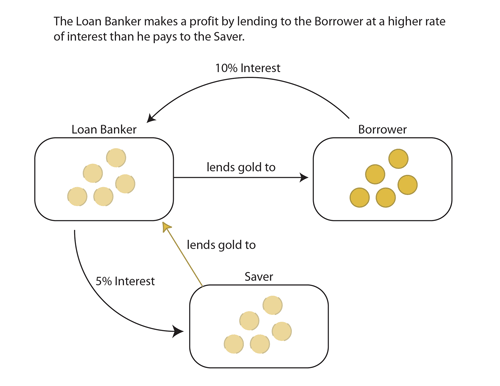
The deposit banker, noticing that at any given time only a portion of the gold in his vault is claimed by depositors, would have been tempted to embezzle his customer’s savings. If he can loan the gold out and have it paid back before the despositor comes to claim it, he can make an additional profit from the interest. The deposit banker doesn’t need to actually lend out the gold, though. He can simply print additonal receipts for gold. Here’s how it works:
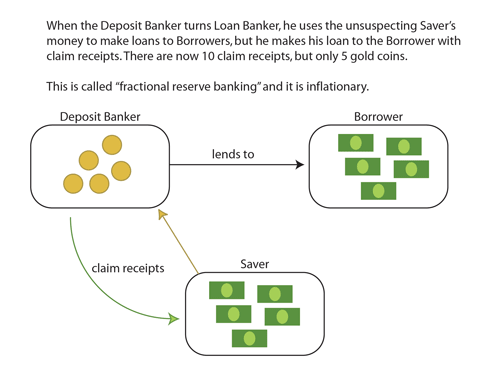
Because the receipts trade as if they ARE gold, and all the receipts are identical (i.e., no one can tell which receipts are backed by gold and which aren’t) this practice is inflationary. The paper has become the money supply. This type of inflation is known as “fractional reserve” banking. The banker prints receipts so that only a “fraction” of the receipts actually represent gold in “reserve” in the vault.
Fractional reserve banking inherently causes an expansion and contraction of the money supply. Here’s why:
Let’s assume that the fraction kept in reserve is 10%. That means for every 10 receipts there is one gold coin.
A banker with 5 coins will then have 50 receipts in circulation
If the banker wishes to keep this 10% ratio – what happens when the banker gets a new customer with gold to deposit?
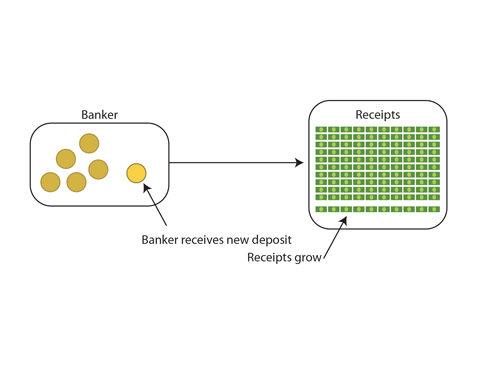
What happens when one of his customers asks for his gold back?
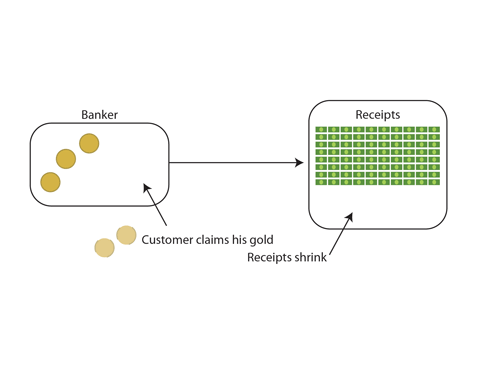
The simple redemption of a receipt by a customer has resulted in a contraction of the supply of money. This is in fact what causes the cycle of booms and recessions that we see in the market. That’s right, the boom and bust business cycles are the product of fractional reserve banking and are NOT an intrinsic part of free market capitalism.* In fact, in a free market capitalist system the fractional reserve banker COULD NOT EXIST. This is because the fractional reserve banker could not prevent another banker from opening up shop and redeeming the first banker’s receipts thereby draining all the gold from his vaults.
Here’s how:
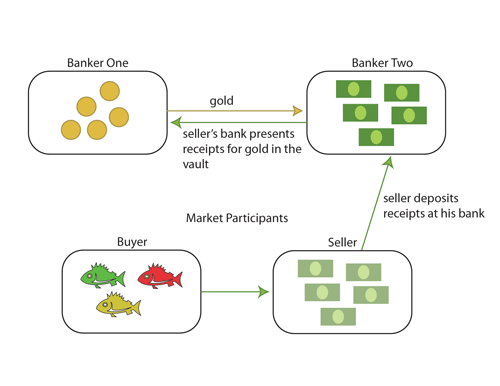
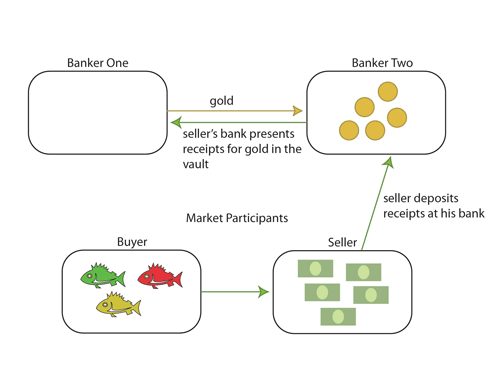
But all banks today DO practice fractional reserve banking. How do they do it?
One way a banker could avoid having to pay out the gold in his vault is to BE THE ONLY BANKER of course. In order to do this bankers seek to be what I call the One and Only Bank or the OOB. The only way to do this is by force, so the aspiring OOB must convince the government with it’s police and armed forces to back it. This is in fact exactly what has happened in history, from the early central banks of England and the United States to today’s modern central banks in nearly every country. The current central bank in the United States (that’s right, there were others before it) is called the Federal Reserve. (The history of central banking in America is fascinating reading. I highly recommend A History of Money and Banking in the United States: The Colonial Era to World War II
by Murray Rothbard.)
But aren’t there many banks in the United States? It does seem like there are, but in fact they are all part of the Federal Reserve System which enables all banks to act as if there is only one. The Federal Reserve does this by acting as a “bankers’ bank.” Here’s how:
The Federal Reserve controls the “reserves” of each bank acting as a lender when the banks reserves get low and also feeding reserves into the system as a means to “stimulate” the economy. We’ll discuss this further in a minute. For now, you can see that the Federal Reserve allows the bankers to “get away” with a fractional reserve system by shifting reserves between the banks as if they were in fact, one bank.
Of course, the Federal Reserve is only ONE central bank of many. What about the world? In fact, many times in history countries have gotten into big trouble because of their fractional reserve policies. All sorts of temporary schemes have been used to deal with this issue. They are beyond the scope of this article, but they are worth studying. (If this topic interests you, see my recommended reading list at the end of this post.)
With this in mind, let’s discuss how the Federal Reserve implements monetary policy.
In order to add “reserves” to the accounts of each bank, the Federal Reserve conducts what are known as “Open Market Purchases.” This simply means that the Federal Reserve buys something on the open market, just as you or I would buy something. An easy way to see how this works is to imagine an individual selling an item to the Federal Reserve and receiving a check in return. The individual then deposits this check in his own bank and the new money enters the banking system. The new money does not simply enter the first bank’s reserves and that’s it, though. Remember, the system is fractional reserve. The first bank keeps a portion of the new money, and loans out the rest. In this manner, if the system is a 10% reserve system, evey 10 dollars the Fed prints ends up adding 100 dollars to the money supply. Here’s how:
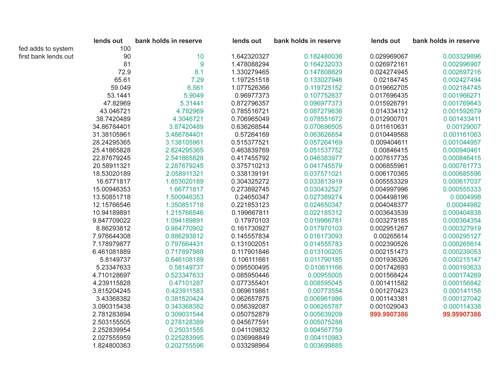
Now we can see one way by which inflation and deflation could happen “at the same time.” In fact they happen in different spheres of the banking system. For example, for the sake of clarity, let’s call the amount of gold in reserve, “the monetary base.” It is the basis of any fractional reserve expansion of the money supply. Could the monetary base grow while the money supply in it’s entirety shrinks? Maybe you can think of ways this could happen. Because the banking system is fractional reserve, if the Fed wants to add $100 to the money supply, it must go through the banks. But does that $10 added to the banking system necessarily come out $100? For example, what if for each $10 that the Fed tried to add to the banking system $20 was removed by the bank’s customers and kept as cash? Remember, part of a bank’s reserves are it’s customer’s deposits. This is merely one way this could happen. A banker could in fact decide to keep more in reserve, if he is particularly worried about borrowers being able to pay back their loans.
Now, throughout my examples of fractional reserve banking, I’ve used gold as the reserve. In fact, today, no country uses a gold standard. The US went completely off the gold standard in 1973. Today the paper receipts are backed by nothing by a promise. They are essentially IOUs. Another point to remember: the Fed doesn’t buy just anything in the open market, it in fact buys Treasuries. If you think it sounds crazy, you’re not alone. In fact, the US Dollar is worse than an IOU, it’s an IOU on top of an IOU!
This explanation of how the banking system works is really very simplified, but you have to start somewhere and my hope is that it will help you to decifer some of the events you see unfolding today, like the housing crisis, subsequent bank failures, and the stock market crash. You know now that this “bust” period is inevitable as long as there is a system of fractional reserve banking.
If this topic interests you and you would like to delve deeper into the economic processes involved, I highly recommend the following books and websites:
The Mystery of Banking by Murray Rothbard – out of print, but available FOR FREE in pdf format from The Ludwig von Mises Institute.
What Has Government Done to Our Money? and The Case Against the Fed
both by Murray Rothbard.
A History of Money and Banking in the United States: The Colonial Era to World War II by Murray Rothbard
The Creature from Jekyll Island: A Second Look at the Federal Reserve by G. Edward Grffin
* Again, this is a very simplistic explanation, the purpose of which is to explain the basics to a beginner. In truth, with any large inflationary event a bust period is likely because inflation causes a dislocation in market that must then be corrected. If you are interested in Austrian Business Cycle Theory, I recommend visiting The Ludwig von Mises Institute, or if you are really ambitious, pick up a copy of Human Action.

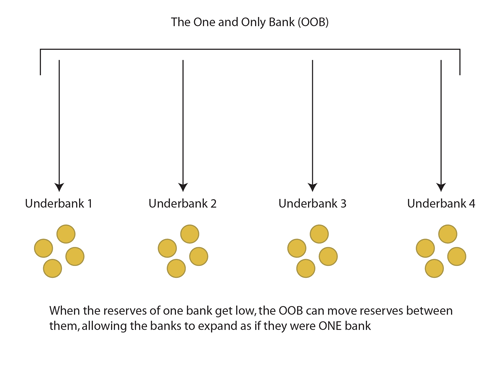

1 Comment